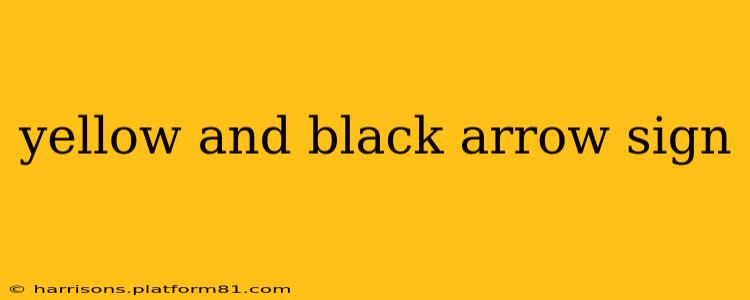The ubiquitous yellow and black arrow sign is more than just a splash of color on the road; it's a crucial piece of traffic infrastructure that directs drivers, cyclists, and pedestrians. Understanding its nuances is essential for safe and efficient navigation. This comprehensive guide will delve into the meaning, variations, and implications of this common sign, answering many frequently asked questions.
What Does a Yellow and Black Arrow Sign Mean?
A yellow and black arrow sign generally indicates mandatory guidance on the road. Unlike white arrows that suggest preferred routes, yellow and black arrows are directives, often appearing in situations where safety or clarity are paramount. They direct traffic flow, highlighting upcoming turns, lane changes, or merging points. Ignoring these signs could lead to accidents or traffic violations. The color combination – high-visibility yellow on a dark background – is specifically chosen to instantly grab the driver's attention.
What are the Different Types of Yellow and Black Arrow Signs?
Several variations exist, each with its own specific meaning:
- Straight Arrow: This indicates that you must continue straight ahead.
- Left Arrow: This indicates that you must turn left.
- Right Arrow: This indicates that you must turn right.
- Combination Arrows (e.g., Left and Straight): This shows the permitted directions of travel; you may proceed straight or turn left, but not right.
- Curved Arrow: Indicates an upcoming curve and the appropriate direction to follow around the bend.
- Arrow with Additional Symbols: Often paired with other symbols (like a bicycle or pedestrian), indicating shared lanes or dedicated paths.
What Happens if I Don't Follow a Yellow and Black Arrow Sign?
Failure to obey a yellow and black arrow sign can have several consequences:
- Accidents: Disregarding the directions can lead to collisions with other vehicles or pedestrians.
- Tickets: Law enforcement can issue tickets for failing to follow traffic signals and signage.
- Points on Your License: Depending on the jurisdiction and the severity of the infraction, points might be added to your driving record.
- Insurance Increase: Accumulating traffic violations can result in higher insurance premiums.
Is a Yellow and Black Arrow Sign the Same as a White Arrow Sign?
No, while both indicate direction, they have distinct meanings. White arrows are advisory, indicating preferred or suggested routes. You can deviate from a white arrow if necessary, while a yellow and black arrow mandates adherence. The difference is crucial for understanding your responsibilities as a road user.
Are there any situations where a yellow and black arrow sign might not be present?
Yes, older roads or less trafficked areas might not have the most up-to-date signage. Always be vigilant, observing traffic patterns and other road markings to supplement signage. Also, temporary situations such as road construction might necessitate changes that aren't yet reflected in permanent signage.
How can I better understand road signage in my area?
Understanding local signage is vital. Consult your local Department of Transportation or equivalent agency's website for comprehensive road signage guides and maps. Driver's education materials often cover this in detail as well.
Conclusion
The yellow and black arrow sign plays a critical role in ensuring road safety. Understanding its meaning and variations is crucial for all road users. Always pay close attention to this vital piece of traffic guidance to ensure a safe and efficient journey. Remember that adhering to traffic signs is not merely a suggestion but a legal obligation, vital for preventing accidents and maintaining order on our roads.
